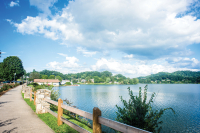Rafting’s restrained rebound: Commercial outfitters attempt to paddle back from record rain year
 The summer is shaping into a pretty good rafting season for Tee Davis.
The summer is shaping into a pretty good rafting season for Tee Davis.
“It’s awesome, man,” said Davis, owner of Smoky Mountain Adventures.
Much better than last summer, anyway. Last year, rains wreaked havoc on the rafting season.
“Night and day,” Davis said. “It helps when the river’s not out of its banks.”
And while this year’s looking better than last, even “awesome,” no one’s calling it great. Indeed, a drive into Nantahala Gorge can be a solitude experience.
Related Items
Bill Reynolds, assistant manager of Wildwater-Nantahala Gorge Adventure Center, reckons he could go stand in the middle of the highway running through the gorge, a route lined with rafting ventures, without much worry of traffic.
“We’re right on U.S. 74,” Reynolds said. “Seventy-four should be a hustling, bustling highway this time of year.”
But after a steady holiday stretch, Davis said he was enjoying the post-Fourth of July lull in traffic. He estimates his staff is too.
“We ran straight for seven days, so we’re all a little whipped,” Davis said.
Washout wallop of 2013
Last year was a wet year. It rained. A lot.
“It didn’t stop raining until almost August,” said Juliet Jacobsen Kastorsf of Endless River Adventures. “Last year was a lot of people’s worst year. It was a tough year.”
“Last year was like a 100-year event,” said Nathan Dewhurst, river ranger with the Nantahala Ranger District of the U.S. Forest Service, .
The summer of 2013 was wet overall. But in July, it was torrential, spiking flow rates to well beyond the commercial rafting comfort zone.
“It put the water level too high,” recalled Brenda Dills of Carolina Outfitters.
While average flow rates for the Nantahala River hover around 500 cubic feet per second (cfs), last July the rains caused that rate to spike to 4,000 cfs. On the Tuckasegee River, July rates climbed from their average of 1,000 cfs to around 15,000 cfs.
“Last year, we had to turn people away because of the flooding,” Reynolds recalled.
When rains push the rivers too high, rafting companies shut down operations. Depending on the particular river and the amount of rain, rafting can be put on hold for anywhere from a few hours to much longer.
“The Forest Service doesn’t have a strict cutoff,” said Dewhurst. “The outfitters have kind of an association and they come up with some guidelines and ground rules. They’re not strictly enforced but are more of a gentleman’s agreement.”
“We cancelled all of our trips over 2,500 cfs,” said Davis. “We had to wait about a week and a half before we could go out and then we had to do guided trips.”
Even when rains weren’t pushing rivers to beyond-raftable levels, the wet summer still kept the rafters away.
“Numbers are always going to be down when you have lots of rain,” Reynolds said.
Even if river levels stay well below concern, people don’t rush to raft in the rain. They want blue skies and sunshine.
“Great, sunny weather brings everybody out,” said Davis.
Jacobsen Kastorsf doesn’t believe it was always like this. She recalls a day when people made the trek to Western North Carolina and were content if weather mandated they stay inside and play board games. Now, she says, people set their watches by the weather.
“They don’t leave Atlanta if it looks like there’s a chance it might rain, it’s crazy,” Jacobsen Kastorsf said. “It’s just a society change. We want everything to be perfect. The truth is Americans are allergic to rain.”
A short season and some slow days
Davis exhibits a good bit of enthusiasm about business this year. He describes it as a “banner” season thus far. His compadres in the rafting economy are more reserved. They use words like “average,” “normal” and “better.”
“It just seems steady,” said Steven Mats, of Adventurous Fast Rivers Rafting. “We’re just kind of rolling along.”
While anecdotal reports — rafting companies aren’t anxious to share exact numbers — from the gorge for May and June paint a favorable start to the season, the pace quickened over the recent holiday weekend.
“Fourth of July it kicked into high gear,” said Jacobsen Kastorsf.
But on the other side of the Fourth of July the rafting scene seems to have cooled off a bit. Showers have hung out in the forecasts and business has slowed.
Now, U.S. 74 is quieter, even as the sun peels through the clouds to call the weatherman’s bluff. It’s a beautiful day, but rather quiet in rafting country.
“I’m not sure exactly how to take this week just yet. Just going to Bryson City, going to the bank and the tag office, not a lot of people,” said Reynolds. “If we get some sunshine and we get these high percentages of rain to go away maybe we could get these tourists.”
And while slow days are nice for resting up after a holiday haul, they can add up fast when summer is short. With the average summer break shrinking for many students and their families, rafting companies have a tighter window during which to make their money.
“The problem you’re going to have is you’re going to have this compressed season,” said Jacobsen Kastorsf, already eyeing the end. “Now, what you’re looking at is 30 days. After the first week of August, weekends will be busy, but that’s it.”
With hints of rain sprinkling the forecasts, coupled with a shorter season and less-than-enthused economy, this season may be hard pressed to provide the bounce that rafting businesses need following last summer’s dismal showing.
“I think it will be real hard for most people in the tourism industry to make up for last year,” Jacobsen Kastorsf said.









